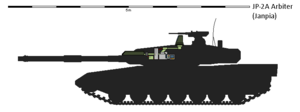EZV-3 sight system
The Electronics Zelenny Vision GEN III, also known as the EZV-3, is a Janpian tank panoramic sight system developed by Electronics Design Bureau of the Zelenny Industrial Workers' Union. The sight system was initially made for the JP-2A Arbiter, but it was later made available for any armored vehicles, thanks to its modularity and open architecture. This allows the sight system to be applied on any vehicles fitted with Rakata BMS, as well as any battle management structure for foreign use. The sight system features day and night hunting capabilities in 1,316 x 480 resolution, as well as a 10,000-meter-ranged, eye-safe, methane-pumped, Raman-shifted laser rangefinder that can be replaced with solid-state fiber.
Development
With the introduction of the JP-2A "Arbiter" Tank, the Workers of Zelenny Industrial Union, specifically the electronics design bureau, have developed an advanced sight properly fitted for such a tank that abides by the doctrine of "who fires first, wins". In order to fire first, one must be able to acquire a target. And once the target has been acquired, the tank must be able to take it out in a single shot in order to avoid retaliation and without any obstruction. Under this mindset, the Zelenny Electronics Design Bureau has embarked on a development for a new fitting sight system to fulfill such goals, utilizing the same Rakata BMS for its fire control interface, allowing the tank to contextually understand the levels of threats, as well as other features that allow the tank to automatically identify and aim at enemy weakspots, with the information taken from the database. With these BMS programs, the tank can determine which targets pose much more of a threat, making the top of the threat heirarchy being a target priority. It can also recommend the crew on how to proceed with the engagement, lead or direct shots, all with the ballistic, temperature, wind, range, current round on the breech, as well as the barrel wear based on the amount of ammunition shot, being taken into account. Furthermore, with the AI programs, the EZV-3 has a built-in machine learning system, which would further help synthesize and analyze targets or situations, allowing for better judgement recommendation from the Rakata BMS.
With the fire control aspects already granted from a combat-proven battle management system, work has started to allow the BMS programs to interact with the sight systems, to utilize the fire control programs to its maximum extent. Using the Rakata BMS as a starting point, as well as the former sights used on the earlier JP-2 variant, the design bureau began researching and studying the best way to extend the range from the former sight system and further the digital recognition range, all while keeping the sight functional and unaffected on both day and night conditions. The result of the concept formula (CONFORM) is the EZV-3 sight, a name that stands for Electronics Zelenny Vision GEN III. After follow-up tests and other features, the sight has finally been put for the Arbiter Tank and put on to service.
Features and specifications
The EZV-3 is a gyroscopic, panoramic tank optic that has a two-axis stabilizer, that is also equipped with a high-definition, dual-band 3rd gen FLIR. It streamlines the hunter-killer system, improves the tank's sight capabilities as opposed to the former, and gives the commander a wide range of view with its 360 degree LOS. Thanks to its stabilizers, this makes the sight stable even while the tank is moving through rough terrain, allowing either the commander or the gunner to pick up any targets and properly identify it within -20 to +60 angle.
With an ICT Generation III+, the crew can effectively see targets in both day and night conditions in 1,316 x 480 resolution thanks to its 12 – 17 µm spectral bandmaking detector technology. Since most direct combat happens at a 1 to 8-kilometer range, the BMS program connected to the sight system can digitally recognize a target at around 7,000 meters in day or night conditions. However, this does not include the non-digital recognition, which can theoretically run up to 12,000 meters due to its high spectrum, and target it at up to 10,000 meters due to the laser rangefinder's capabilities. This laser rangefinder, to be specific, is an eye-safe, methane-pumped, raman-shifted laser, which can also be swapped for a solid-state fiber for the non-gas-state version. In total, the EZV-3 sight has a 0.05 milliradian error margin to the gun, and has a fully colored magnification and target identification levels of 3x, 6x, 13x, 16x, 25x, and 50x digital zoom. The EZV-3 also has a focal-point array, dewar cooler bench, and instant calculation electronics to convert thermal radiation into identifiable video images.
Among the components of the EZV-3 is its own 30V electrical unit that is connected to the entire sight system, as well as digitalized main control unit, which are all connected to a four-bar linkage drive units. The digitalized main control unit has the weaponry traverse control program, thermal optics control panels, and gun position sensors. It also has a switch unit program in case the crew needs to switch roles (commander to gunner or vice versa), as well as a connector unit that utilizes inputs from the Rakata BMS database. This connector unit allows the sight to also function as a fire control system, utilizing the Rakata BMS and its database to utilize the main gun. The system also utilizes 4 sights which is the main commander sight, main gunner sight, gunner auxilliary sight, and a back-up gunner sight. All of which are accessible to everyone's crew consoles, giving them access to increase situational awareness or incase one of the sights got knocked out. With plans to export it in mind, these sight components can be fixed into any modularities, making it an open architecture system which would depend on the designer placement.
Components
The EZV-3 Sight syetm features multiple subcomponents:
- Rakata BMS Database Array (changeable)
- Dual ZEGTC Control/Ballistic Unit
- EZSP Switch Unit
- Electrical Unit
- Thermal Optics Control Panels
- Weaponry Traverse Control Unit
- Four-bar Linkage Drive Units
- Main Sensor Systems:
- Main Gunner Sight
- Main TC Sight
- Back-up Sight
- Auxiliary Sight
These sub-components can be alternated with different systems as part of its open architecture feature and to ease maintenance or upgrade concerns.



